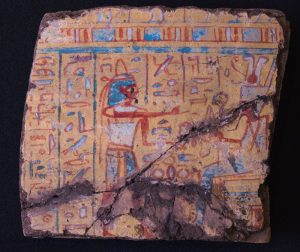W1052
W1052
 This coffin fragment shows the dead person (central) with a cone of incense on their head. Some say an actual perfumed wax cone was worn, others believe that the cone shape simply symbolises the perfume. Others say that it shows the person was divinised. The dead person is here shown as a man, although, as the inscription states, she was a woman, a chantress of Amun. At this period figures alternate between male and female as they were mass produced as unisex coffins.
This coffin fragment shows the dead person (central) with a cone of incense on their head. Some say an actual perfumed wax cone was worn, others believe that the cone shape simply symbolises the perfume. Others say that it shows the person was divinised. The dead person is here shown as a man, although, as the inscription states, she was a woman, a chantress of Amun. At this period figures alternate between male and female as they were mass produced as unisex coffins.
The dead person is standing in front of an offering table. On the other side of the offering table is the god of the dead, Osiris, seated and holding a crook and flail. The heka crook was a symbol of Upper Egypt, and the nekhekh flail a symbol of lower Egypt. Both were symbols of kingship. Note that Osiris also wears a mummy bandage.
The other scenes on this coffin would probably have shown the dead person on their journey to the afterlife. The scenes would therefore have been similar, though not identical, to the complete coffin of another female musician of Amun-Re which stands in this gallery.
The yellow background and crowded scene on this coffin dates it to the Third Intermediate Period (1069-747BC) and most likely to the 21st Dynasty (1069-945BC). Non-royal elite persons of this period were normally buried in two anthropoid coffins with a mummy board.
Very few private coffins of this period have been discovered outside Thebes so it is possible that this coffin is from Thebes. In addition, the musician who owned this coffin worshipped the god Amun-Re whose temple was at Thebes.
Other Third Intermediate Period Coffin Fragments in the Egypt Centre